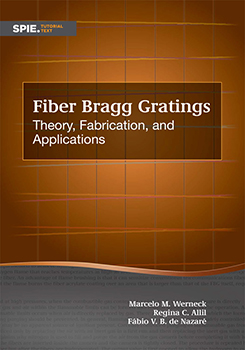|
The development of optical fibers has revolutionized not only telecommunications but also the way monitoring and sensing is conducted, particularly in remote or harsh environments. In this context, the discovery of photosensitivity in optical fibers led to the establishment of fiber Bragg gratings (FBGs), optical filters that have been widely employed in telecom and as measurement elements.
This Tutorial Text discusses these optical devices directly, focusing on the practical aspects and applications. It addresses the fundamental aspects of FBG operation to quickly introduce the subject to students, engineers, and laboratory technicians. Due to their inherent advantages in instrumentation, sensing, and automation systems, FBGs play an important role not only for industry professionals but also for academics. Thus, this book is primarily intended for scientists, professors, researchers, students, photonics technicians, and engineers involved in optical-fiber projects.
The chapters follow a logical sequence: after a discussion of the primary concepts, practical aspects regarding the development of a FBG laboratory and how these components are manufactured and used in practical applications are presented. The following chapters outline the operation of Bragg gratings and, for instance, discuss how measurement information can be retrieved (interrogation techniques), calibration methods, and how to prepare and deploy the devices in real monitoring conditions. The final chapters present several successful, real-world applications of the technology.
Fiber Bragg Gratings: Theory, Fabrication, and Applications delivers essential information concerning FBGs to professionals and researchers with an approach based on rules of thumb and practical aspects, enabling quick access to the main principles and techniques, and allowing readers to set up their own laboratory or application. It provides detailed information about how to operate and use these novel sensors, particularly with respect to the required infrastructure, daily operation, and possible applications. Dense physical aspects and the associated refined mathematical models are not thoroughly presented because this information can be found in other publications.
Many of the applications in this book reflect our own experience in courses, M.S. dissertations, D.S. theses, and projects at the Laboratório de Instrumentação e Fotônica (LIF) of the Universidade Federal do Rio de Janeiro. Therefore, we acknowledge our former and present students who made it possible to accomplish all of work that went into this book. We also acknowledge the contributions of the following D.S. students: Marceli Nunes Gonçalves and Leandro Alves Garção for writing Chapter 12, and Bruno Cerqueira Rente Ribeiro for writing Chapter 16.
Marcelo Martins Werneck
Regina Célia da Silva Barros Allil
Fábio Vieira Batista de Nazaré
Universidade Federal do Rio de Janeiro
July 2017
|



